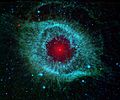Spitzer Space Telescope facts for kids

An artist rendering of the Spitzer Space Telescope.
|
|
| Names | Space Infrared Telescope Facility |
|---|---|
| Mission type | Infrared space telescope |
| Operator | NASA / JPL / Caltech |
| Website | www.spitzer.caltech.edu |
| Mission duration | Planned: 2.5 to 5+ years Primary mission: 5 years, 8 months, 19 days Elapsed: 20 years, 7 months, 26 days |
| Spacecraft properties | |
| Manufacturer | Lockheed Ball Aerospace |
| Launch mass | 950 kg (2,094 lb) |
| Dry mass | 884 kg (1,949 lb) |
| Payload mass | 851.5 kg (1,877 lb) |
| Start of mission | |
| Launch date | 25 August 2003, 05:35:39 UTC |
| Rocket | Delta II 7920H |
| Launch site | Cape Canaveral SLC-17B |
| Entered service | 18 December 2003 |
| End of mission | |
| Disposal | Deactivated in Earth-trailing orbit |
| Deactivated | 30 January 2020 |
| Orbital parameters | |
| Reference system | Heliocentric |
| Regime | Earth-trailing |
| Eccentricity | 0.011 |
| Perihelion | 1.003 AU |
| Aphelion | 1.026 AU |
| Inclination | 1.13° |
| Period | 373.2 days |
| Epoch | 16 March 2017 00:00:00 |
| Main telescope | |
| Type | Ritchey–Chrétien |
| Diameter | 0.85 m (2.8 ft) |
| Focal length | 10.2 m (33 ft) |
| Wavelengths | infrared, 3.6–160 μm |

|
|
The Spitzer Space Telescope is a telescope launched into space by NASA in 2003. It is the fourth telescope in the Great Observatories program (the Hubble Space Telescope was the first). The Hubble Space Telescope takes pictures of visible light, and the Spitzer Space Telescope takes pictures of infrared light. Unlike Hubble, Spitzer orbits the Sun instead of the Earth.
The Spitzer Space Telescope is named after the scientist Lyman Spitzer. It was planned to last for 2.5 years, but it actually lasted until 2009. Some parts of the telescope are still working even today.
Discoveries
The Spitzer Space Telescope was able to see very good detail. Spitzer was the first telescope that could see light from extrasolar planets (planets outside the Solar System.) It was also able to see some of the first stars in the universe, believed to be only 100 million years after the Big Bang.

Images for kids
-
An animation of Spitzer Space Telescope trajectory relative to Earth. Spitzer Space Telescope · Earth
-
The Cepheus C & B Regions. – The Spitzer Space Telescope (30 May 2019).
-
The Spitzer's first light image of IC 1396.
-
The Helix Nebula, blue shows infrared light of 3.6 to 4.5 micrometers, green shows infrared light of 5.8 to 8 micrometers, and red shows infrared light of 24 micrometers.
See also
 In Spanish: Telescopio espacial Spitzer para niños
In Spanish: Telescopio espacial Spitzer para niños











